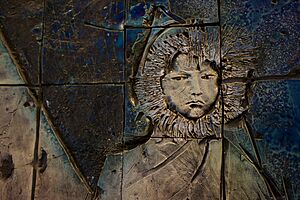Jordi Bonet facts for kids
Quick facts for kids
Jordi Bonet
|
|
|---|---|
 |
|
| Born | May 7, 1932 |
| Died | December 25, 1979 |
| Nationality | Canadian |
| Known for | painter, ceramic artist, muralist, and sculptor. |
Jordi Bonet was a famous artist born in Spain. He became a Canadian citizen and worked mostly in Quebec. He was a painter, a ceramist (someone who makes art from clay), a muralist (who creates large wall paintings), and a sculptor (who makes statues). He was born on May 7, 1932, and passed away on December 25, 1979.
Contents
Jordi Bonet's Early Life and Art Journey
Jordi Bonet was born in Barcelona, Spain. When he was nine years old, he lost his right arm. His childhood was also affected by the Spanish Civil War. He studied art in Barcelona.
He started by working with paint and ceramics. Later, he began creating art with metal and concrete. These were often large relief sculptures, which are artworks that stick out from a flat surface.
Moving to Canada and Creating Art
In 1954, Jordi Bonet moved to Canada. He settled in Quebec and continued his art studies there. After a short trip back to Spain, he opened his own art studio in Mont-Saint-Hilaire in 1960.
Over the next 20 years, he created over 100 artworks. These pieces can be found in Quebec and other countries. He even worked with other famous artists like Salvador Dalí.
Important Artworks by Jordi Bonet
In 1964, the government of Sierra Leone asked him to create a mural. This large wall painting can still be seen on the front of the Bank of Sierra Leone building in Freetown. You can find his signature, "Jordi Bonet '64," at the bottom right.
In 1967, Jordi Bonet created a special artwork called The Inuit Family. This rotunda (a round building or room) shows life in northern Newfoundland and Labrador. It is located inside the main entrance of the Charles S. Curtis Memorial Hospital in Saint Anthony, Canada.
One of his most famous works is a relief sculpture in the Grand Théâtre de Québec. This artwork caused a stir in 1971 because it included a line from a poet named Claude Péloquin. The line translated to: "Aren't you sick of dying, you gang of idiots? Enough!"
Other major works by Bonet include:
- A relief called L’homme devant la science on a building at Université Laval in Quebec.
- Citius, Altius, Fortius (which means Faster, Higher, Stronger in Latin) at the Montreal Metro station Pie-IX.
- Hommage à Gaudí, a series of wall sculptures at Place des Arts in Montreal.
- The Halifax Explosion Memorial Sculpture in Nova Scotia.
- Stained-glass windows and sculptures at Our Lady of the Skies Chapel at John F. Kennedy International Airport in New York City.
Jordi Bonet was very interested in creating art for churches and religious places. He made artworks and special objects for churches and convents in Quebec, Ontario, and other areas. His art was shown in Galerie L'Art français starting in the 1950s.
Jordi Bonet was one of Quebec's most important artists. He passed away from leukemia when he was 47 years old.

Honours and Awards
Jordi Bonet was recognized for his artistic talent. He was a member of the Royal Canadian Academy of Arts.
Images for kids
-
Relief sculpture at Sonia Shankman Orthogenic School on the campus of and affiliated with the University of Chicago
-
Mosaic in Moncton, New Brunswick
-
Mural on the Adrien-Pouliot Building of Laval University, Quebec City
-
Resurgence (1977), in the lobby of the Oceanic Tower in Vancouver
-
Mural on the front of The Bank of Sierra Leone building in Freetown
- ''The Inuit Family'' 1967: Mural on the rotunda of Curtis Memorial Hospital, St-Anthony, Canada
-
These people wear traditional clothing
See also
- List of Canadian artists
- Jordi-Bonet Bridge linking Mont-Saint-Hilaire and Belœil (french)
- Jordi-Bonet bridge, toponymy, origin and meaning (french), Montérégie















